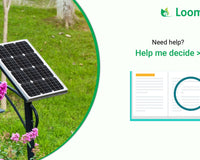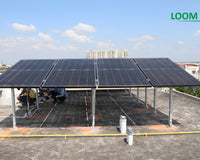Tamil Nadu is one of the most industrialised states in India with a high Human Development index. It is situated at the south eastern end of the Indian peninsula , between Latitude 8° 5' N and 13° 35' N and between Longitudes 76° 15' E and 80° 20'E.
Tamil Nadu Electricity Board (TNEB) was formed on July 1, 1957 under section 54 of the Electricity (Supply) Act 1948 in the State of Tamil Nadu as a vertically integrated utility responsible for power generation, transmission and distribution.
Solar Panel Price in Salem in 2024
With the continuous up-gradation on solar panels esp in technology, also the changes in tax regime the prices of solar panels have seen an increase of up to 50% over the last few years. While prices have gone high, to a certain extent the increased efficiency of solar panels has helped keeping the value proposition in place. Solar power continues to be the most preferred resource for renewable energy.
In Salem, with the presence of 150 solar solutions shops along with 50 inverter battery shops and 100 electrical shops are within reach of any customer.
Solar Panel Cost: The price of solar panels varies with the technology, type, size, scope of government subsidy etc.
Generally, solar panels or solar PV modules that have higher capacities are at a lesser cost on per watt calculation vs the small capacity panels as their cost goes higher on per watt basis.
Solar Panel Cost
|
Solar Panel Type |
Price |
|
Cost of one Solar Panel |
Rs. 1,000 to 25,000 |
|
Cost of small Solar Panel |
Rs.1,000 to 3,000 |
|
Cost of Portable Solar Panel |
Rs 3,000 to 7,000 |
|
Cost of 12v Solar Panel |
Rs.1,000 to 9,500 |
|
Cost of 24v Solar Panel |
Rs 20,000 to 25,000 |
Application: Solar power system is looked as an independent of power solution by many and similarly a lot believe it to be a power backup solution. Technically both are true as the solar system can independent power source -ie -
Off Grid Solar Power System - Such system are deployed where the power outage is too frequent, or long power cuts or low voltage conditions. Also places where getting electricity to reach is still a challenge, such a solution is a boon. Subsidy in such a case is not an option.
Price of Off Grid Solar Power System
|
Solar System Size |
Price |
|
1 kW Off Grid Solar System |
Rs. 96,000 |
|
2 kW Off Grid Solar System |
Rs. 1,92,000 |
|
3 kW Off Grid Solar System |
Rs. 2,88,000 |
|
5 kW Off Grid Solar System |
Rs. 4,80,000 |
|
7.5 kW Off Grid Solar System |
Rs. 7,20,000 |
|
10 kW Off Grid Solar System |
Rs. 9,60,000 |
|
15 kW Off Grid Solar System |
On Demand |
|
25 kW Off Grid Solar System |
On Demand |
|
50 kW Off Grid Solar System |
On Demand |
On Grid Solar Power System -this system is connected with the Grid and is provisioned to avail subsidy. More interestingly the MNRE has recently introduced a new process that will help the home owners to avail the subsidy by getting few entries along with the digital pic of theirs on a specified portal. This initiative has made the entire process for users very convenient and simple. Users who want to leverage the subsidy and the benefits of lower electricity bills tend to avail this.
Price of On Grid Solar Power System
|
Solar System Size |
Price |
|
1 kW On Grid Solar System |
Rs. 60,000 |
|
2 kW On Grid Solar System |
Rs. 1,20,000 |
|
3 kW On Grid Solar System |
Rs. 1,80,000 |
|
5 kW On Grid Solar System |
Rs. 3,00,000 |
|
7.5 kW On Grid Solar System |
Rs. 4,00,000 |
|
10 kW On Grid Solar System |
Rs. 6,00,000 |
|
15 kW On Grid Solar System |
Rs. 8,25,000 |
|
25 kW On Grid Solar System |
Rs. 13,75,000 |
|
50 kW On Grid Solar System |
Rs. 25,00,000 |
| 100 kW On Grid Solar System | Rs. 60,00,000 |
Hybrid Solar system- Hybrid is a combination of above 2 with the help of certain control mechanisms
Price of Hybrid Solar Power System
|
Solar System Size |
Price |
|
1 kW Hybrid Solar System |
Rs. 1,15,000 |
|
2 kW Hybrid Solar System |
Rs. 2,30,000 |
|
3 kW Hybrid Solar System |
Rs. 3,45,000 |
|
5 kW Hybrid Solar System |
Rs. 5,75,000 |
|
7.5 kW Hybrid Solar System |
Rs. 8,62,500 |
|
10 kW Hybrid Solar System |
Rs.11,50,000 |
|
15 kW Hybrid Solar System |
On Demand |
|
25 kW Hybrid Solar System |
On Demand |
|
50 kW Hybrid Solar System |
On Demand |
Applications like : homes, SOHO, shops, farms, farmhouses, look for the opportunity to deploy solar solutions.
How to Find Information about Subsidy?

Tamilnadu Generation & Distribution Corporation (TANGEDCO) is only one DISCOM where residential homeowners can find Net metering and Subsidy Information of Tamilnadu state.
Subsidy Eligible for Solar Rooftop

For the purpose of this component of the programme, Residential RTS plant would be the solar power system installed mainly on the roof of a residential building having an active residential power connection from the local DISCOM, and would also include installations on open contiguous land within the premises of the Residential building.
The CFA pattern for the residential sector will be as follows:
Type of residential sector CFA (as percentage of benchmark cost or cost discovered through competitive process whichever is lower) Residential sector (maximum up to 3 kW capacity) 40 % of benchmark cost**
Residential sector (above 3 kW capacity and up to 10 kW capacity)*40 % up to 3 KW Plus 20% for RTS system above 3 kW and up to 10 kW
Group Housing Societies/Residential Welfare Associations (GHS/RWA) etc. for common facilities up to 500 kWp (@10 kWp per house), with the upper limit being inclusive of individual rooftop plants already installed by individual residents in that GHS/RWA at the time of installation of RTS for common activity.
20 % *The residential sector users may install RTS plant of even higher capacity as provisioned by respective State electricity regulations; however, the CFA will be limited up to 10 kWp capacity of RTS plant.
Documents Required
NON-CFA
- Photograph of the beneficiary. (JPG below 300KB)
- Scanned copy of latest Electricity Bill (PDF below 3MB)
- Site Photographs (Pre installation) for Subsidy (JPG below 2MB)
CFA
- Copy of the invoice (PDF below 200KB)
- Technical specification details of Solar Panels and invertors .(PDF below 200KB) ( Download Here )
- Bill of Material. (PDF below 200KB)
- Site Photographs (After installation) for Subsidy (JPG below 200KB)
- Copy of grid clearance /Net meter installation certificate issued by DISCOM. (Copy of Electricity Bill ) (PDF below 200KB)
- Joint Inspection - Join Commissioning Report ( Download Here )
Benchmark costs as per MNRE, 2024
The Benchmark costs for Grid Connected Rooftop Solar Power Plants for the Year 2019-20 communicated by MNRE is as under:-
| Capacity | Benchmark cost (Rs/Wp) |
|---|---|
| Above 1KW– 10 KW | 54 |
| Above 10 KW – 100 KW | 48 |
| Above 100 KW | 45 |
The Benchmark costs for Grid Connected Rooftop Solar Power Plants for the Year 2020-21 communicated by MNRE is as under:-
| Capacity | Benchmark cost (Rs/Wp) |
|---|---|
| Up to 1KW | 54 |
| Above 1 kW and upto 2 kW | 43 |
| Above 2 kW and upto 3 kW | 42 |
| Above 3kW and upto 10kW | 41 |
| Above 10 kW and upto 100 kW | 38 |
| Above 100 kW and upto 500 kW | 36 |
PHASE-II Grid connected Solar rooftop programme
The Cabinet Committee on Economic Affairs (CCEA) has approved the Phase-2 of Grid Connected Roof top Solar programme for achieving cumulative capacity of 40 GW from Roof top Solar (RTS) projects by 2022 through a total Central Financial support of Rs.11,814 Cr. This scheme is proposed to be implemented through the Electricity Distribution Companies (DISCOMs).
The brief of different components/ incentives are as follows:
Component A : Central Financial Assistance (CFA) to residential sector – 4GW:
- CFA at 20% for capacity beyond 3 kWp and upto 10 kWp
- CFA at 20% for Group Housing Societies (GHS)/Residential Welfare Associations (RWA) capacity upto 500 kWp (limited to 10 kWp per house and total upto 500 kWp).
- Domestic manufactured modules and Solar cells to be used.
- CFA shall be on benchmark cost of MNRE for the State/UT or lowest of the cost discovered in the tenders for that State/UT in that year, whichever is lower.
Component B: Incentives to DISCOMs – for initial 18 GW Capacity:
- Progressive incentive for DISCOMs for achievements above baseline (the cumulative RTS capacity installed at the end of previous financial year).
- No incentives for capacity addition up to 10%
- 5% incentives for addition beyond 10% and upto 15%
- 10% incentives for addition beyond 15%
Frequently asked Questions?
1. What is a Solar Rooftop System?
In a solar rooftop system, the solar panels are installed in the roof of any residential, institutional, social, Government, commercial, industrial buildings etc.
2. What is a Grid Connected Solar Rooftop System?
In grid connected rooftop or small SPV system, the DC power generated from SPV panel is converted to AC power using Inverter and is fed to the grid either of 440/220 Volt three/ single phase line installed at residential, institution/commercial establishment. These systems generate power during the day time which is utilized by powering captive loads and feed excess power to the grid as long as grid is available. In case, where solar power is not sufficient due to cloud cover etc., the captive loads are served by drawing balance power from the grid.
3. What are the main components?
Solar PV Modules/Solar Panels – The Solar PV modules/Solar Panels convert solar energy to electrical energy. They are available in different technologies such as Mono Crystalline, Poly Crystalline, thin film, CIGS, CdTe, HIT, etc. Poly Crystalline Solar PV panels are most common in use on roof tops.
4. What is net-metering?
The grid connected rooftop system can work on net metering basis wherein the beneficiary pays to the utility on net meter reading i.e. the difference between the import and the export energy, if the imported energy is more than the exported energy. If the exported energy is more than the imported energy the utility will pay to the beneficiary for the net energy exported. This concept is applicable to the solar applications registered before 25.03.2019. Thereafter, net feed-in method of billing is applicable.
Inverter – Inverter converts DC output of Solar PV panels into AC power.
Mounting structure – The mounting structure is the support structure that holds the Solar PV panels
Balance of System – These consist of cables, switchboards, junction boxes, meters, structures, earthing system ,circuit breaker, fuses etc.
3. What is net feed-in scheme?
Under net feed-in scheme for the applications registered on or after 25.03.2019, the surplus/excess energy generated that is unutilized and that flows to the grid at the end of the billing period will be calculated at a tariff fixed by the Hon’ble Commission and credited to the consumer’s account. The energy that is imported from the grid by the consumer will be calculated at the appropriate retail tariff and the monetary value of imported energy debited from the available credit on account of exported energy in the respective billing period. Any credit available in the account of the consumer after debiting value of imported energy will be carried over to the next billing period for adjustments against subsequent billing. If the amount to be debited is higher than the credit in a billing period, the consumer will have to pay the difference in charges..
4. How & how much subsidy on solar can be availed?
The Benchmark costs for Grid Connected Rooftop Solar Power Plants for the Year 2020-21 communicated by MNRE is as under:-
| System | Govt. Subsidy | Customer Price |
| Up to 3kW | 40% | |
| Above 3kW to Upto 10kW | 20% | |
| Above 10kW | 0% | |
| Cost of 3kW Solar System | Without Subsidy | 1,80,000 |
| Customer Payable Amount | With Subsidy (- Rs. 72,000) | 1,08,000 |
| Cost of 5kW Solar System | Without Subsidy | 3,00,000 |
| 3kW | 40% Subsidy (3*24,000) | -72,000 |
| 2kW | 20% Subsidy (2*12,000) | -24,000 |
| Customer Payable Amount | With Subsidy (-96,000) | 2,04,000 |
| 5kW - Generation | Benefits | Units - Rs. 7.5/U |
| Daily Genration | 25 Units | 187 |
| Monhtly Genration | 625 Units | 4687 |
| Yearly Generation | 7,500 Units | 56, 250 |
| Lifetime Generation | 1,87,500 Units | 14,06,250 |
| Return on Investment | 3.6 years | |
| Income | 6.89X | |
| Installation Area | ||
| 1. | Mono Perc | 500 sq.ft. |
| 2. | Shark 440W - 540W | 300 sq.ft. |
7. How much capacity one can install?
Depending on the sanctioned demand of the existing service, load requirement of the beneficiary and availability of shadow free rooftop area, the beneficiary may decide the capacity upto 150 kW under LT service.
8. How the cost of project will be arrived?
TEDA will finalize the list of empanelled vendors, float tenders and fix the project cost for the installation of Rooftop Solar domestic services throughout the State.
9. How can a beneficiary select a vendor?
The consumer is having the option to choose the vendors among the list of empanelled vendors finalized by TEDA. TEDA will issue work order to the vendor. .
10. Who will do the feasibility analysis?
The concerned Executive Engineer/O&M will complete the feasibility analysis of distribution transformer capacity based on the verification by the Assistant Executive Engineer/O&M concerned. After receipt of feasibility report from Executive Engineer/O&M the same has to be informed to TEDA for issue of work order to the vendor to install the plant as per the technical standards..
11. Request for grid connectivity/ Net meter
On installation of the PV plants by the vendor, the vendor/consumer will send the readiness report to TANGEDCO. After completing the inspection by AEE/O&M for installations of capacity of 10 KW and by CEIG for installations of capacity of above 10 KW , on receipt of inspection report, bi-directional meter will be installed by TANGEDCO for providing grid connectivity.
12. How the subsidy is disbursed?
On registering the applications in TANGEDCO's Unified Solar Rooftop Portal(USRP), the consumer has to choose the vendor from the empanelled vendor's list . After the issue of work order by TEDA, the vendor will install RTS. The consumer has to make payment to the vendor after deducting the eligible CFA amount. The vendor can claim the CFA from Tamil Nadu Energy Development Agency(TEDA), the implementing agency. TANGEDCO will release the CFA amount to TEDA for onward disbursement to the vendor.
13. How much area is required for a 1 kW rooftop Solar PV system?
A 1 kW rooftop system generally requires 10 sq. meters of shadow-free area. Actual sizing, however, depends on local factors of solar radiation and weather conditions, efficiency of solar module, shape of the roof etc.
14. What are the advantages of Grid Connected Rooftop Solar (RTS) System?
- Cheaper and environment friendly electricity.
- Excess energy can be fed into the grid with tariff as determined by the State Electricity Regulatory Commissions .
- Electricity generation occurs at consumption center thus, saving transmission and distribution losses
- Lower payback period.
- 25 years guaranteed lifespan of the solar photovoltaic panels
- Highly modular
- 25 years guaranteed lifespan of the solar photovoltaic panels
- Subsidy is available from the Central Government for domestic category (residential) of LT consumers.
- Quick installation
15. Can a Grid Connected RTS System generate electricity during the night? How do we get power during the nights/monsoons?
Grid Connected RTS System cannot generate electricity during the night. In the absence of generation during night/monsoon, power supply will be fed from the grid.
16. How much time will be required for installation of a Grid Connected Rooftop Solar (RTS) System?
Grid Connected Rooftop Solar (RTS) system can be installed within one or two months depending on the capacity of PV plant and also under the scope of the vendor.
17. How much electricity does a Grid Connected Rooftop Solar (RTS) System Generate?
The Grid Connected Rooftop Solar (RTS) system installed on a roof will generate an average of 4 to 5 units of electricity per kWh per day.
18. Do I need a permission from the Municipal Authorities or Pollution Control Board?
Not required.
19. What kind of electrical loads can be connected with Rooftop Solar (RTS) System?
All kind of loads, including inductive, capacitive and lighting load in category of LT services expect hut and agriculture can be connected with Rooftop Solar (RTS) system.
20. What is the lifespan of the RTS plant?
A Grid Connected Rooftop Solar (RTS) power plant has a lifespan of 25 years.
21. Are there any incentive/subsidy available? Where shall I contact for availing subsidies?
Under Phase-II Grid Connected Rooftop Solar Scheme(GCRTS) of Ministry of New and Renewable Energy(MNRE), the consumer can avail Central Financial Assistance(CFA) under Component A as follows:
Component A : Central Financial Assistance (CFA) to residential sector – 4GW:
- CFA at 40% for capacity upto 3 kWp
- CFA at 20% for capacity beyond 3 kWp and upto 10 kWp.
- CFA at 20% for Group Housing Societies (GHS)/Residential Welfare Associations (RWA) capacity upto 500 kWp (limited to 10 kWp per house and total upto 500 kWp).
- Domestic manufactured modules and Solar cells to be used.
- CFA shall be on benchmark cost of MNRE for the State/UT or lowest of the cost discovered in the tenders for that State/UT in that year, whichever is lower
- The CFA shall be permissible only if domestic manufactured Solar Panels (using domestic manufactured Solar cells) are used by the beneficiary.
Tamil Nadu Energy Development Agency(TEDA) is the implementing agency in Tamil Nadu for implementing the phase-II of Grid Connected Rooftop Solar Scheme(GCRTS).
The consumer has to make payment to the vendor after detecting the eligible CFA amount. The vendor can claim the CFA from Tamil Nadu Energy Development Agency(TDEA), the implementing agency. TANGEDCO will release the CFA amount to TEDA for onward disbursement to the vendor.
23. Where shall I submit the application for subsidy?
Applications for non- subsidized Solar Rooftop projects shall be submitted through TANGEDCO’s Unified Solar Rooftop portal.
Consumers under residential category who are willing to avail Central Financial Assistance (CFA) under Phase-II of Grid Connected Rooftop Solar Scheme (GCRTS) shall submitted their applications through TANGEDCO’s Unified Solar Rooftop Portal(USRP).
24. From where can I find the status of my application?
- Status of applications for non- subsidised Solar Rooftop projects can be traced through TANGEDCO’s Unified Solar Rooftop portal(USRP).
- Status of applications under residential category seeking Central Financial Assistance (CFA) under Phase-II of Grid Connected Rooftop Solar Scheme (GCRTS) can be traced through TANGEDCO’s Unified Solar Rooftop Portal(USRP).
25. Who are the empanelled vendors for installation of the System?
Consumers under residential category who are willing to avail Central Financial Assistance (CFA) under Phase-II of Grid Connected Rooftop Solar Scheme (GCRTS) shall choose the vendor from the list of empanelled vendors in the TANGEDCO’s Unified Solar Rooftop Portal .
Before installing a Grid Connected RTS System do I need to inform the Power Utility (TANGEDCO)? How can we approach?
- Yes
- Consumer can register directly through Unified Solar Rooftop Portal if they are not willing to avail CFA.
- Applications under residential category to avail Central Financial Assistance (CFA) from MNRE under Phase-II Grid Connected Solar Rooftop Systems will have to be registered through TANGEDCO’s Unified Solar Rooftop Portal(USRP) . On submission of Application Form, TANGEDCO will check the technical feasibility and provide a response through the portal/intimation besides intimating to TEDA for issue of work order to vendor
26.How are the billing and payments made by TANGEDCO for the grid connected solar rooftop services.?
For the applications registered before 25.03.2019 , under Solar Net Meter Category based on Tamil Nadu Solar Policy 2012 the following billing procedure is adopted:
In any billing cycle if the energy imported by the consumer is more than the energy exported to the grid over and above his self consumption, then the import kwh and export kwh are adjusted and the bill will be raised for payment by the Consumer as per existing norms and the applicable service connections tariff. In any billing cycle, if the energy exported exceeds energy imported, the surplus of export Kwh over import Kwh shall be carried over to the next billing cycle for adjustment against the import Kwh of that billing cycle.
For the applications registered on or after 25.03.2019 , under Solar Netfeed-in Category based on Tamil Nadu Solar Energy Policy 2019 the following billing procedure is adopted:
Energy settlement will be done on monthly basis. The electricity generated by the RTS will be utilised for the self consumption by the consumer. The excess unutilized energy flowing into the grid and recorded in the export register of the meter will be credited into the consumers account at a tariff fixed by the Regulatory Commission. The energy that is imported from grid by the consumer will be calculated at the appropriate retail tariff and the monitory value of imported energy debited from the available credit on account of exported energy in the respective billing period. Any credit available in the account of the consumer after debiting the value of imported energy will be carried out to the next billing period. If the amount to be debited is higher than the credit in a billing period, the consumer will have to pay the difference in charges. At the end of the settlement period monitory value of surplus generation, if any will be settled by TANGEDCO.
27. Is CEIG Approval Compulsory?
For installed PV systems of capacity above 10 KW, CEIG approval is compulsory.
28. What are the Electricity Standards to be followed to install Grid Connected SRTPV System?
Consumer has to comply with CEA standards and relevant safety standard as followed by CEIG.
29. Are bank loans available for installation of Solar Rooftop Systems? Can we approach banks through single window portal?
Yes, some banks provide loans especially for Solar Rooftop Systems. .
30. What are the documents necessary for registering application for solar rooftop systems?
Document for proof for the existing service in the name of the applicant for solar installation, any one of the valid ID issued by Government such as Aadhar card/Driving license/Voter’s ID/Passport for proof..
31.What is the time limit for effecting Solar Net feed-in services?
Time schedule as specified by the TNERC schedule and as per the norms in vogue will be followed..
Disclaimer: Loom Solar or our partner does not provide a solar subsidy of rooftop solar panel installation.












